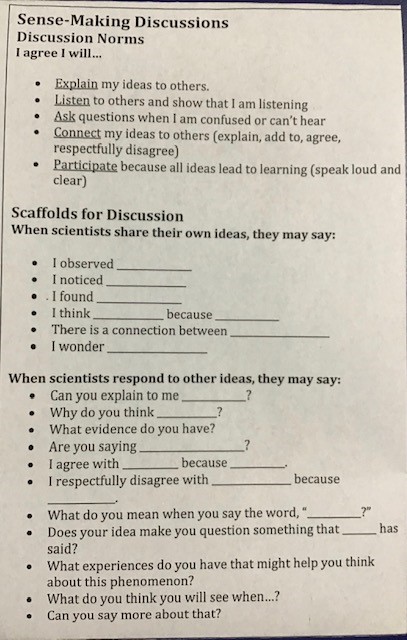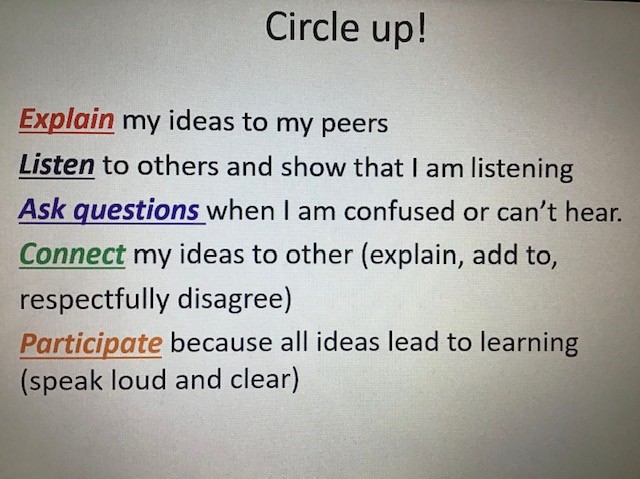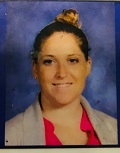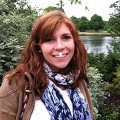Next Gen Navigator
Making Students’ Thinking Visible Through Discussion by Dana McCusker and Marisa Miller
By Kate Falk
Posted on 2020-02-26
As the assistant director of science for Mastery Charter Schools I have had the pleasure of working with Dana McCusker and seeing her excellent teaching in action. As a science teacher leader, she has been at the forefront of utilizing discussion resources and supporting other teachers in our network to use them in their classrooms. Here is Dana describing how she uses discussion to make students’ thinking visible:
As the fourth-grade science teacher at my school, it is my job to not only teach my students about science concepts, but also to teach them how to “do” science. The vision for science education articulated in A Framework for K–12 Science Education states, “The learning experiences provided for students should engage them with fundamental questions about the work and with how scientists have investigated and found answers to those questions.” (Framework p.9) “How do I make this happen in my classroom?,” you ask. In addition to engaging my students in the science and engineering practices, I give students ample chances to make their thinking visible through discussion. This gives both me and my students another way to see their growth from start to finish in an investigation and put it all together to end the unit.
The key to getting all my students to participate in the discussion is to give them some time beforehand to think and write about a shared experience with a phenomenon or investigation. Seeing what the students write also provides me a window into their thinking so I can better guide the discussion.
I have my students sit or stand in a circle for the discussion. I make myself a part of the group by putting myself on the students’ level, sitting or standing in the circle, to emphasize they are not looking at me, but at one another. This builds our classroom community and helps them see themselves as scientists: that everyone can engage in argument from evidence.
A few weeks ago, my students worked to discover the natural processes of physical and chemical weathering. They had prior knowledge about physical weathering from a previous investigation in which they observed models of physical weathering, developed their own ideas, and then learned the academic vocabulary associated with physical weathering, but they had no classroom experience with chemical weathering. We started class with an initial ideas discussion when I showed them a picture of the Grand Canyon and a picture of the Rocky Mountains.
I gave them five minutes to write about what they observed in the pictures, then asked them to join their groups. They had a few minutes to discuss their observations and ideas before sharing them with the class. I have found that whole-class discussions are more successful when students have had a chance to talk about their ideas in small groups first, which relieves any nervousness. Here is what happened during the whole-class discussion that day:
Teacher: Let’s bring it back to the whole class and discuss what is going on in the pictures. I am going to ask this group to share what they have been discussing with the whole class.
Student 1: Based on what we learned the last couple of days, physical weathering is happening in both, [as] it is clear that pieces of the rocks or mountains are missing.
Student 2: I agree, but it looks like different types of physical weathering [are happening] because of the environmental factors. For example, the Rocky Mountains have snow covering them, so they are probably breaking down by freezing and thawing. In the Grand Canyon photo, it looks like there is a river flowing through, so I’m guessing water abrasion is playing a big part here. I also know that there can be wind or sandstorms in the desert, so maybe wind abrasion, too.
Student 3: I agree with all of this, but I think there is something else going on. Does anyone else notice that they are different color[ed] rocks? I am not sure if this is because of the rocks themselves, or if there is another factor playing a part. And if it is something else, is this also causing the rocks to break down even more, or is it changing the color, or both?
Student 4: I don’t think that the color is a sign of the rocks breaking down; I think they are that color because of their environment.
Teacher: What makes you think this?
Student 4: Well, I was thinking of it in the way that when we spend time in the sun, our skin changes, and usually gets darker, which almost looks like what is happening with the rocks, that maybe the sun is a factor in the color.
Teacher: That is an interesting way to think about it! So it sounds like we can all agree that there is some kind of physical weathering going on in both of the pictures, correct?
Class: Yes!
Teacher: Is there anyone who could elaborate more on what Student 4 said about the color of the rocks? Are there any experiences you have had that might help you think about this phenomenon?
This is the moment when I considered what my students said about the different colors of the rocks and introduced a new investigation in which they observed chemical reactions on different rocks.
During discussions, I ask probing questions and encourage students to ask one another probing questions. Each student has the following Sense-Making Discussions student reference sheet in their notebooks, and the expectations for discussions appear on the board. I made this reference sheet several years ago, editing it over the years using discussion norms from The Inquiry Project and question stems from OpenSciEd, to help the students feel more confident during the discussions, especially at the beginning of the school year.


In my classroom this year, I have used the discussion framework from OpenSciEd to differentiate between initial ideas, building understanding and consensus discussions. These discussions are a chance to support all students in my science classroom, especially the students who may not see themselves as scientists or who struggle with other subjects, like writing. Supporting all students is extremely important to me because I was that student who didn’t see myself as a scientist and who struggled in other subjects because I didn’t always have that teacher to help me to realize my strengths.
In addition to the discussion resources from OpenSciEd, I also use resources from STEM Teaching Tools, such as this one on expectations and discourse moves. What discussion supports do you provide to students in your class?
 Dana McCusker is a fourth-grade science teacher at Mastery Charter School-Smedley Elementary in Philadelphia, Pennsylvania, recently named a Title 1 Distinguished School by the Pennsylvania Department of Education. She loves to bring real-world experiences into her classroom and foster investigative science lessons and discussions on all types of scientific concepts. She has a bachelor’s degree in secondary education and Spanish from La Salle University in Philadelphia, and a master’s in education with a dual certificate in elementary and special education from Arcadia University in Glenside, Pennsylvania, a Philadelphia suburb. When she was approached to pilot a new science program for Mastery seven years ago, she jumped at the opportunity in order to provide a quality science education to her students. During this time, she crafted lessons and fine-tuned her own science knowledge, and showed her students how science is just magic you can prove. She served as a science content lead teacher for the Mastery Charter School network for four years, and serves as a teacher leader at her school. She is a sports fanatic and the proud wife of her golf-loving, accountant husband, and the proud mom of a very curious and active three-year-old girl, with another baby due in April!
Dana McCusker is a fourth-grade science teacher at Mastery Charter School-Smedley Elementary in Philadelphia, Pennsylvania, recently named a Title 1 Distinguished School by the Pennsylvania Department of Education. She loves to bring real-world experiences into her classroom and foster investigative science lessons and discussions on all types of scientific concepts. She has a bachelor’s degree in secondary education and Spanish from La Salle University in Philadelphia, and a master’s in education with a dual certificate in elementary and special education from Arcadia University in Glenside, Pennsylvania, a Philadelphia suburb. When she was approached to pilot a new science program for Mastery seven years ago, she jumped at the opportunity in order to provide a quality science education to her students. During this time, she crafted lessons and fine-tuned her own science knowledge, and showed her students how science is just magic you can prove. She served as a science content lead teacher for the Mastery Charter School network for four years, and serves as a teacher leader at her school. She is a sports fanatic and the proud wife of her golf-loving, accountant husband, and the proud mom of a very curious and active three-year-old girl, with another baby due in April!
 Marisa Miller is the assistant director of science for Mastery Charter Schools. Mastery Charter is a network of more than 20 schools, many of them turnaround schools, in Philadelphia, Pennsylvania, and Camden, New Jersey. In her role, Miller supports science teachers in grades 3–12 through teacher coaching and curriculum and professional development. Before entering her current role, Miller taught biology and middle school science for five years. She holds a bachelor’s degree in biology and secondary education from The College of New Jersey and a Masters in Science Education from Rutgers University in New Jersey. Miller works to advance science education and three-dimensional learning as a former member of Achieve’s Peer Review Panel and current member of NSTA’s 3-D Learning Cadre. Like McCusker, she also has a very rambunctious three-year-old and is expecting another baby in April. You can connect with her on Twitter: @marismiller6.
Marisa Miller is the assistant director of science for Mastery Charter Schools. Mastery Charter is a network of more than 20 schools, many of them turnaround schools, in Philadelphia, Pennsylvania, and Camden, New Jersey. In her role, Miller supports science teachers in grades 3–12 through teacher coaching and curriculum and professional development. Before entering her current role, Miller taught biology and middle school science for five years. She holds a bachelor’s degree in biology and secondary education from The College of New Jersey and a Masters in Science Education from Rutgers University in New Jersey. Miller works to advance science education and three-dimensional learning as a former member of Achieve’s Peer Review Panel and current member of NSTA’s 3-D Learning Cadre. Like McCusker, she also has a very rambunctious three-year-old and is expecting another baby in April. You can connect with her on Twitter: @marismiller6.
Note: This article is featured in the Fenruary 2020 issue of Next Gen Navigator, a monthly e-newsletter from NSTA delivering information, insights, resources, and professional learning opportunities for science educators by science educators on the Next Generation Science Standards and three-dimensional instruction. Click here to sign up to receive the Navigator every month.
Visit NSTA’s NGSS@NSTA Hub for hundreds of vetted classroom resources, professional learning opportunities, publications, ebooks and more; connect with your teacher colleagues on the NGSS listservs (members can sign up here); and join us for discussions around NGSS at an upcoming conference.
The mission of NSTA is to promote excellence and innovation in science teaching and learning for all.
Disclaimer: The views expressed in this blog post are those of the author(s) and do not necessarily reflect the official position of the National Science Teaching Association (NSTA).
Earth & Space Science Equity Inquiry Science and Engineering Practices Teaching Strategies Elementary


